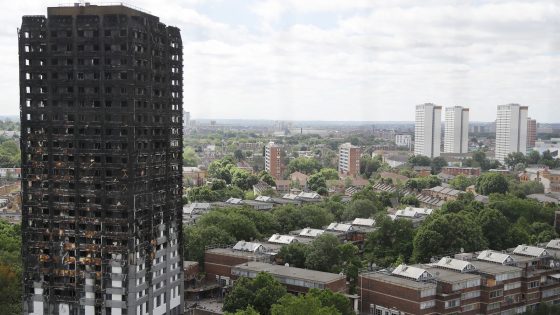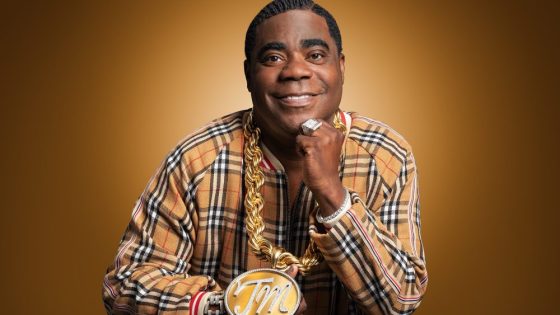A landmark report into the Grenfell Tower fire named and shamed companies which it said were responsible for the 2017 disaster which claimed the lives of 72 people.
The report, the final phase of a seven-year public inquiry into the fire at the west London high-rise building, concludes that incompetence, dishonesty and greed led to the “avoidable” deaths.
Inquiry chairman, Sir Martin Moore-Bick, described “systematic dishonesty” on the part of manufacturers, involving deliberate manipulation of the testing process for materials used on the Grenfell Tower.
He added that “warning signs” about materials being used in buildings were emerging as early as 1991.
Sky News takes a look at the different companies involved in the disaster at the 24-storey residential block.
Arconic
Arconic’s subsidiary, Arconic Architectural Products SAS (AAP), manufactured and sold ‘Reynobond 55 PE’ – rainscreen panels used in the external wall of Grenfell Tower.
They are made of two thin sheets of aluminium with a polyethene core, a highly flammable material.
In a statement, AAP said: “We reject any claim that AAP sold an unsafe product.
“AAP did not conceal information from or mislead any certification body, customer, or the public.
“This product was safe to use as a building material, and legal to sell in the UK.”
AAP said it has also made “financial contributions to settlements for those affected, as well as to the restorative justice fund”.
Kingspan
Kingspan made the insulation used on about 5% of the building behind the Arconic panels. It claims the ‘K15’ insulation boards – made of combustible materials – were installed incorrectly.
Kingspan said in a statement that the report “explains clearly and unambiguously that the type of insulation (whether combustible or non-combustible) was immaterial, and that the principal reason for the fire spread was the PE ACM cladding, which was not made by Kingspan”.
Kingspan added it had “long acknowledged the wholly unacceptable historical failings that occurred in part of our UK insulation business… but they were not found to be causative of the tragedy… and has already emphatically addressed these issues”.
Read more:
‘It could have been me’: The children who survived Grenfell
What happened in the Grenfell Tower fire
Grenfell Inquiry report main findings
Celotex
Celotex made most of the insulation used on the building behind the panels. Its product ‘RS5000’ was marketed as being fully safe when it wasn’t. The company removed the product from the market after the Grenfell Tower fire.
It said in a response to Sky News it was considering the report’s contents “with care”.
“Our business’s response to what happened started immediately after the fire in June 2017. We conducted our own review to interrogate the circumstances in which the RS5000 product had been tested, launched and marketed,” it added.
“This review was a significant and thorough undertaking, and the results of that work were disclosed promptly and proactively to relevant stakeholders, including the Grenfell Tower Inquiry.”
It said that since the fire, it had reviewed and improved process controls, quality management and the approach to marketing.
“Celotex Limited continues to cooperate fully with all official investigations into the Grenfell Tower fire,” it said.
“We reiterate our sympathies to everyone affected by the fire.”
Royal Borough of Kensington and Chelsea
Kensington and Chelsea London Borough Council owns Grenfell Tower as part of its council housing stock. It handed over management of the building to the newly-created Kensington and Chelsea Tenant Management Organisation in 1996.
Elizabeth Campbell, the council’s leader, apologised “unreservedly” for “our failure to listen to residents and to protect them”.
In a statement, she said: “We fully accept the findings, which are a withering critique of a system broken from top to bottom.
“It is crystal clear – profits were put before people, clear warning signs were ignored, and Grenfell was wholly avoidable, with failure at every single level.”
Kensington & Chelsea Tenant Management Organisation (KCTMO)
The Tenant Management Organisation managed nearly 10,000 properties on behalf of Kensington and Chelsea London Borough Council, including Grenfell Tower. Following the fire, the Royal Borough of Kensington & Chelsea terminated its contract with KCTMO.
During his comments, Sir Martin said the organisation was “badly run” and “failed” to respond to criticisms of its treatment of residents.
Reacting to the report, it said: “We are acutely conscious of the terrible impact that this tragedy has had on the bereaved, the survivors, their relatives, and the broader Grenfell Tower community.
“We accept that the TMO contributed to this, and we are deeply sorry. We continue to offer our deepest condolences and sympathies to all those affected.
“We sincerely hope that the findings of this comprehensive report will lead to safer homes for all those in social housing.”
The group relinquished its role as a housing provider in February 2018, with day-to-day management of these services returning to the Royal Borough of Kensington and Chelsea.
Harley Facades
A contractor responsible for installing the cladding during the refurbishment of Grenfell Tower.
It blamed manufacturers of the cladding and insulation products, but the Inquiry Panel found the company “did not concern itself sufficiently with fire safety at any stage of the refurbishment”.
Harley Facades has been contacted for a reply.
Rydon
The lead contractor of the refurbishment of Grenfell Tower which blames “dishonesty” from Arconic, Celotex and Kingspan.
The report cited “the lack of knowledge and experience among Rydon’s own employees was such that it did not have a clear understanding of fire safety matters”.
Rydon has not yet issued a statement in response.
Studio E
An architectural practice which designed the refurbishment of Grenfell Tower and went bust in 2020.
The Report states “Studio E, Rydon and Harley all took a casual approach to contractual relations…[and] failed to identify their own responsibilities for important aspects of the design and in each case assumed that someone else was responsible for matters affecting fire safety.”
Studio E was unavailable to respond to a request for comment.
Building Research Establishment (BRE)
BRE is a former UK government laboratory which was privatised in 1997. It makes money by carrying out tests and issuing its own certificates on cladding products.
The organisation said it will be reviewing the report and its recommendations “and will continue to work constructively with government to ensure the new building safety and testing regime delivers on the findings of the Inquiry’s report and is fit for purpose”.
👉 Tap here to follow the Sky News Daily podcast – 20 minutes on the biggest stories every day 👈
British Board of Agreement (BBA)
The BBA issued certificates relating to the performance of the cladding and insulation used at Grenfell Tower.
It said the tragedy had “led to a comprehensive review of safety in the UK construction industry. We have engaged and contributed to this proactively and will continue to do so”.
Local Authority Building Control (LABC)
The LABC is another certification body responsible for approving certain building materials used in the block.
Its statement said: “LABC admitted errors at the very first opportunity and apologised immediately and repeatedly.”
“We take the Inquiry’s conclusions extremely seriously and will continue the process of reform within LABC itself, and the promotion of new standards, the building safety regime and the registration of the building control profession.”
Source Agencies



